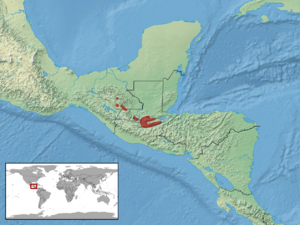Bothriechis aurifer facts for kids
Quick facts for kids Bothriechis aurifer |
|
|---|---|
 |
|
| Conservation status | |
| Scientific classification | |
| Genus: |
Bothriechis
|
| Species: |
aurifer
|
 |
|
| Synonyms | |
|
|
The yellow-blotched palm-pitviper (scientific name: Bothriechis aurifer), also called the Guatemalan palm viper, is a type of venomous pit viper. This snake species is found in parts of Mexico and Guatemala. There are no different types or subspecies of this snake known today.
Contents
What Does the Yellow-Blotched Palm-Pitviper Look Like?
These snakes are usually less than 70 centimetres (28 in) (about 2.3 feet) long. Some can grow to be over 1 metre (3 ft 3 in) (about 3.3 feet) long. They have a thin body and a tail that can grip things, like branches.
Colors and Patterns of the Palm-Pitviper
The snake's main color is green. On its back, it has yellow patches that are outlined in black. You might also see a broken stripe down its back between these patches. Its belly is a lighter yellowish-green color.
On its head, there is a dark stripe behind its eye. The snake's eye is usually yellowish-green, sometimes bronze, with small black spots. Most of these snakes have this dark pattern. However, a few are completely green with no stripes behind their eyes. Young snakes are a pale lime green and have a colorful tail tip.
Where Does the Yellow-Blotched Palm-Pitviper Live?
The yellow-blotched palm-pitviper lives in the mountains of eastern Chiapas, Mexico. It is also found in northern Guatemala. These snakes prefer to live in cloud forests. They are found at high altitudes, usually between 1,200 and 2,300 meters (about 3,900 to 7,500 feet) above sea level.
Is the Yellow-Blotched Palm-Pitviper in Danger?
The yellow-blotched palm-pitviper is listed as Vulnerable (VU) by the IUCN Red List of Threatened Species. This means that scientists believe this snake is at a high risk of disappearing in the wild.
Why is the Palm-Pitviper Vulnerable?
A species is called "Vulnerable" when its living area is small, or its population is breaking into smaller groups. This also happens if its habitat is shrinking or getting worse. The number of adult snakes might also be going down. For the yellow-blotched palm-pitviper, these factors mean it faces a high risk of extinction.


